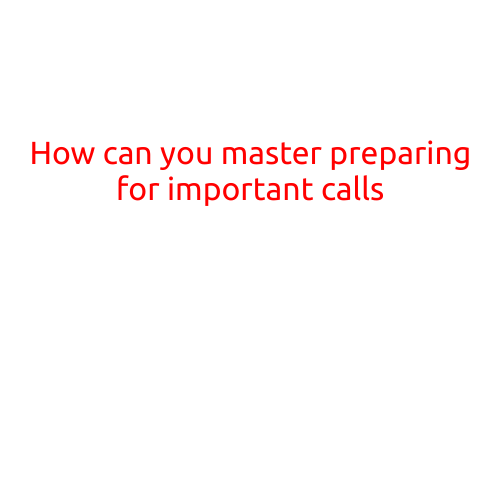
What are Strategies for Creating Positive Impressions over the Phone?
In today’s fast-paced digital age, phone calls have become an essential part of business communication. Many professionals, entrepreneurs, and businesses rely heavily on phone calls to connect with clients, customers, and partners. However, with the rise of digital communication, phone calls can often feel like a novelty. This can lead to misunderstandings, miscommunications, and even lost opportunities. To overcome these challenges, it’s crucial to develop strategies for creating positive impressions over the phone.
1. Prepare Before the Call
Before making a phone call, it’s essential to be prepared. This includes:
- Researching the person or company you’re calling
- Reviewing relevant documents, reports, or information
- Having a clear agenda and objectives
- Being comfortable with the technology and equipment
Preparation shows that you value the other person’s time and intellect, thereby creating a positive impression.
2. Be Professional and Confident
When you answer the phone, use a professional tone and a confident demeanor. This includes:
- Saying hello clearly and promptly
- Using a professional greeting (e.g., “Hello, this is [Your Name]”)
- Speaking clearly and at a moderate pace
- Avoiding filler words (e.g., “um,” “ah”)
- Showing enthusiasm and interest in the conversation
Professionalism and confidence can help establish trust and credibility with the person on the other end.
3. Listen Actively
Actively listening to the person on the phone is crucial for building rapport and understanding. This includes:
- Focusing on the conversation and avoiding distractions
- Showing that you’re paying attention through verbal cues (e.g., “I see”)
- Asking relevant and thoughtful questions
- Paraphrasing and summarizing what the other person has said
Active listening demonstrates that you value the other person’s thoughts and opinions, creating a positive impression.
4. Be Clear and Concise
When communicating over the phone, it’s essential to be clear and concise. This includes:
- Avoiding jargon and technical terms that may be unfamiliar to the other person
- Using simple language and examples
- Keeping the conversation focused and to the point
- Avoiding rambling or going off-topic
Clear and concise communication can help ensure that your message is understood effectively.
5. Follow Up
After the call, it’s important to follow up with the person you spoke with. This includes:
- Sending a summary or recap of the conversation
- Confirming any agreements or next steps
- Showing appreciation for their time and input
- Building on the momentum of the conversation
Following up demonstrates that you’re committed to the relationship and willing to take action, creating a positive impression.
6. Be Authentic and Personal
Finally, it’s essential to be authentic and personal over the phone. This includes:
- Being yourself, without trying to be someone you’re not
- Sharing your personal experiences and insights
- Showing empathy and understanding
- Building rapport and connection with the other person
Authenticity and personal connection can help establish a deep and meaningful relationship with the person on the other end.
In conclusion, creating positive impressions over the phone requires preparation, professionalism, active listening, clarity, follow-up, and authenticity. By implementing these strategies, you can build rapport, establish trust, and grow your professional relationships over the phone. Remember, phone calls can be a powerful tool for business success – don’t underestimate their impact!





